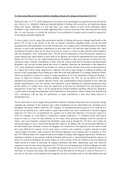To what extent did government methods of dealing with poverty change in the period 1531-76?
During the years 1531-76, Tudor England saw the creation of an increasingly wide gap between the rich and the
poor, however it is debatable whether government methods of dealing with such poverty saw significant change
during this period. Although it is true that there were major reforms to poor relief, particularly during
Elizabeth’s reign, which moved towards supporting those in poverty and away from criticising them for being
idle, it is also necessary to consider the continuity in the punishment of vagrants and the contrast in approaches
to the impotent and able-bodied poor.
To some extent, it can be argued that government methods of dealing with poverty changed significantly in the
period 1531-76 due to the decline in the role of religious institutions regarding charity and the increased
expectation for local parishioners to provide for their poor. For example, prior to the Reformation, the Catholic
doctrine of good works prompted contributions to poor relief both in life and after death through wills, while
monasteries provided a safety net for those in poverty by acting as a source of alms, education and hospitality;
after the dissolution of the monasteries from 1536-40 and the introduction of the Protestantism, donations to
charity instead were made directly to poor relief in the parishes and would be administered by local churches.
Indeed, the 1552 Poor Law Act required parish priests and bishops to place more pressure on those who were
reluctant to make voluntary contributions to alms, while the 12d-per-week fine for recusancy introduced under
Elizabeth’s rule was put towards parish poor relief. In addition, following the dissolution of the chantries in
1547, many almshouses founded by the wealthy as a source of care for the poor were closed, as their possession
of a chapel led to them being categorised as chantries; this led to major changes in methods of dealing with
poverty as the responsibility for providing poor relief fell to the local authorities. For example, Bridewell Palace,
which was donated by Edward to a group of London merchants in 1553 was refounded as Bridewell Hospital, a
source of refuge for homeless or orphaned children. Meanwhile, the 1563 Act for the Relief of the Poor
introduced the position of a special collector of alms, who would demand weekly payments to poor relief and
threaten imprisonment if this was refused; such legislation clearly highlights the important progression from
private charity to a welfare state, where the supervision of the poor was embodied in law and integral to the
management of each town. Thus, it can be argued that government methods of dealing with poverty changed to
a great extent as through the progression from Catholicism to Protestantism, charity became less personal and
more institutional, with the duty for parishioners to make contributions to poor relief being enforced in
parliamentary law.
On the other hand, it can be argued that government methods of dealing with poverty only saw positive change
regarding the treatment of the impotent poor, while punishments for the able-bodied poor remained severe
throughout the period. Indeed, while the 1547 Vagrancy Act permitted the deserving poor to be cared for in a
house for the disabled poor, which marked a great improvement from their confinement to licensed begging
under the 1531 Poor Law, its punishments for vagrants was so harsh that authorities were forced to repeal it in
1550. For example, as a first offence, it stated that a vagrant would have a ‘V’ branded on their chest and be
forced to work as a slave for their informer for two years, while persistent offenders would be executed as
felons; such cruel treatment continued into Elizabeth’s reign, such as through the 1572 Poor Law’s orders for
unlicensed beggars to have a hole bored through their right ear. In addition, this Act increased the difficulty of
the able-bodied poor obtaining a license for begging, as it would have to be signed by two JPs which would
have been difficult for someone of low social status to achieve; this continuity in negative attitudes towards
‘sturdy beggars’ provides a stark contrast to the reformed approach to the impotent poor, as measures in 1552
and 1555 allowed them to be registered and receive badges to display while begging respectively. Furthermore,
significant continuity in government methods of dealing with poverty is demonstrated through the existence of
houses of correction throughout the period. Indeed, as well as being a home for children in poverty, Bridewell
Palace served as a house of correction for vagrants, prostitutes and other ‘undeserving’ poor who would be
required to work for their moral reformation; the 1572 Poor Law encouraged more of these buildings to be built
by parishes with extra poor relief. This was further developed by the Act of 1576, which ordered for there to be
one house of correction per county with stockpiles of wool, flax and iron for the poor to work on. However, it is
true that by this time, the government had recognised the lack of available work for the able-bodied poor and




